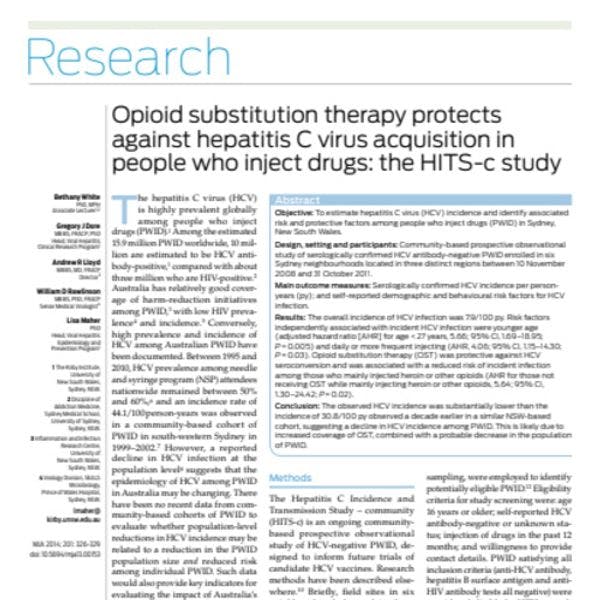Opioid substitution therapy protects against hepatitis C virus acquisition in people who inject drugs
The hepatitis C virus (HCV) is highly prevalent globally among people who inject drugs (PWID). Among the estimated 15.9 million PWID worldwide, 10 million are estimated to be HCV antibody-positive, compared with about three million who are HIV-positive. Australia has relatively good coverage of harm-reduction initiatives among PWID, with low HIV prevalence and incidence. Conversely, high prevalence and incidence of HCV among Australian PWID have been documented.
Between 1995 and 2010, HCV prevalence among needle and syringe program (NSP) attendees nationwide remained between 50% and 60%,6and an incidence rate of 44.1/100 person-years was observed in a community-based cohort of PWID in south-western Sydney in 1999–2002. However, a reported decline in HCV infection at the population level suggests that the epidemiology of HCV among PWID in Australia may be changing. There have been no recent data from community-based cohorts of PWID to evaluate whether population-level reductions in HCV incidence may be related to a reduction in the PWID population size and reduced risk among individual PWID. Such data would also provide key indicators for evaluating the impact of Australia's National Hepatitis C Strategy.
The authors examined the acquisition of HCV among PWID enrolled in a prospective observational study based in Sydney, New South Wales. Specifically, they assessed HCV incidence from 2009 to 2011, and risk and protective factors associated with incident infection, including uptake of NSPs and opioid substitution therapy (OST — methadone or buprenorphine).
The study concluded that HCV incidence was substantially lower than the incidence of 30.8/100 py observed a decade earlier in a similar NSW-based cohort, suggesting a decline in HCV incidence among PWID. This is likely due to increased coverage of OST, combined with a probable decrease in the population of PWID.
Keep up-to-date with drug policy developments by subscribing to the IDPC Monthly Alert.
